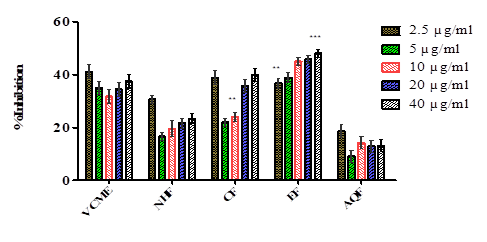Evaluation of Viola canescens Wall Ex. Roxb. for anti-asthmatic and anti-tussive activity and isolation of bioactive compound
Abstract
 Abstract Views: 0
Abstract Views: 0
Folklorically, Viola canescens (VC) is used for the treatment of respiratory disorders, such as cough and asthma. The current study aimed to evaluate VC for anti-asthmatic and anti-tussive activities and isolate the bioactive compound. The plant was collected, extracted, and fractionated, with the isolation of compounds via column chromatography. Solvent extracts of VC were evaluated for anti-asthmatic and anti-tussive activities in animal models. The purified compound obtained from ethyl acetate fraction (EF) via column chromatography was identified by Mass and 1H-NMR spectroscopic techniques. The EF (at 200 mg/kg/day for 21 days) significantly increased latency to pre-convulsive dyspnea (PCD) as compared to control. Similarly, mucous viscosity of the sensitized group was reduced significantly by EF (at 200 mg/kg). In isolated guinea pig’s ileum preparation, the EF (at 25 μg/ml) exhibited maximum relaxant activity (48.83 ± 1.5% inhibition at 0.8 ml) against histamine-induced contractions (p<0.01). The citric acid-induced cough bouts in guinea pigs were significantly reduced by EF (58.13 ± 3.1% at 200 mg/kg). The EF also significantly inhibited the secretion of phenol red dye (43.02 ± 3.1% at 200 mg/kg). A flavonoid (quercetin) was isolated from the EF that may be probably responsible for anti-asthmatic and anti-tussive activities of the plant.
Downloads

UMT Journals are dedicated to fostering knowledge sharing, collaboration, and responsible use of published content. To facilitate these principles, UMT Journals publish articles under specific licenses that define how readers, researchers, and the broader community can use, share, and build upon the published work. Authors retain the copyright to their work while granting UMT Journals the right to publish the article under a specified license.









